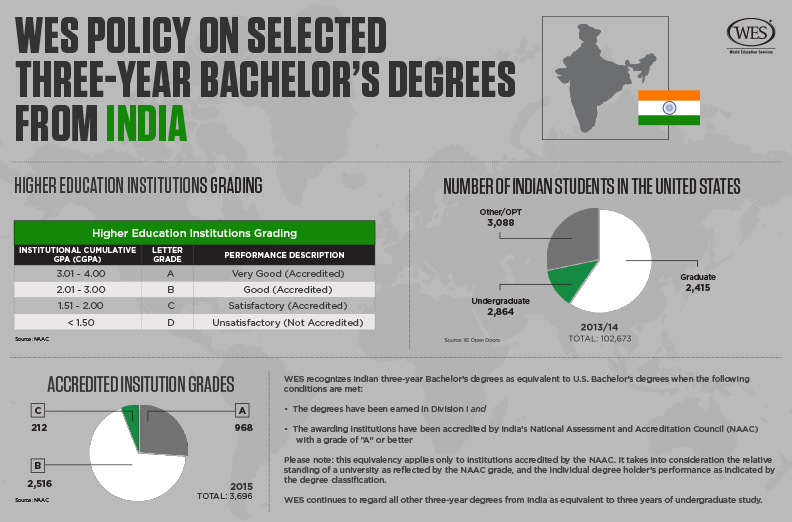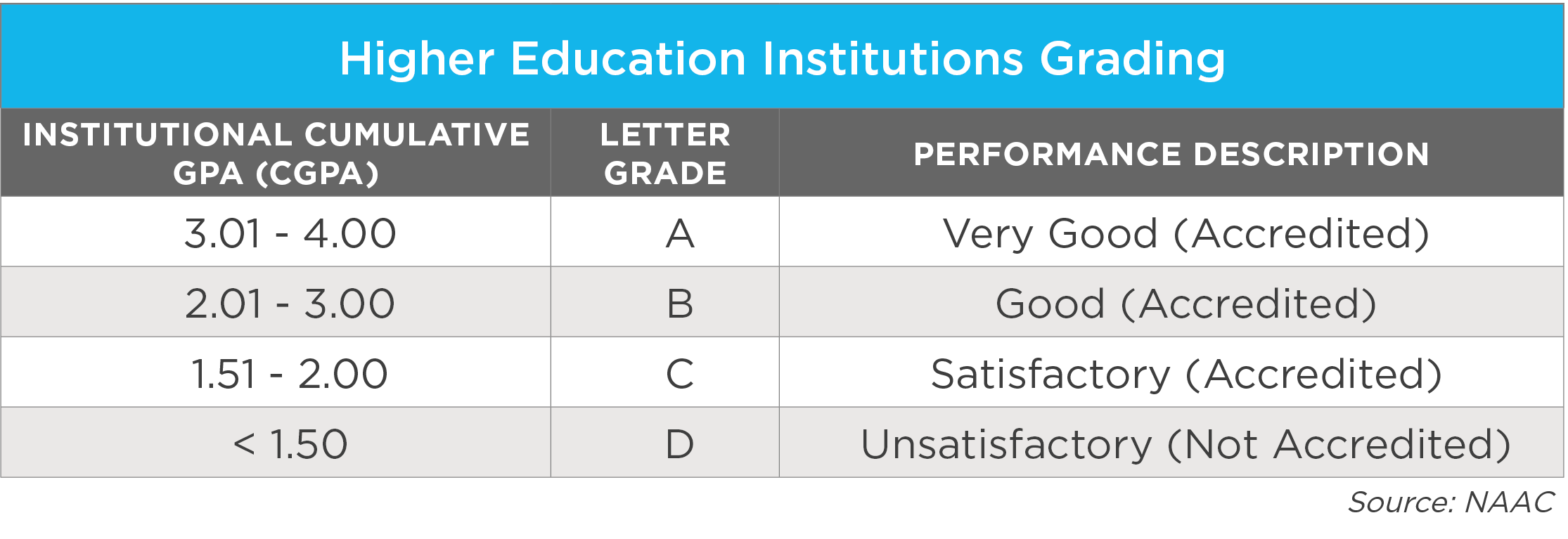WES Policy on Selected Three-Year Bachelor’s Degrees from India
WES Staff
More than 102,000 Indian students were enrolled at a U.S. institution of higher education in 2014. Of these, 60 percent were enrolled at the graduate level. This is a staggering number considering many Indian students face significant hurdles related to the equivalency of their three-year Bachelor of Arts and Bachelor of Science degrees when applying to U.S. graduate schools. Indian applicants are typically required to apply with a minimum of either a two-year master’s degree or a one-year postgraduate diploma in a field related to their undergraduate study.
The reasoning is based mainly on an accounting of total years of schooling. It is the same methodology that U.S. graduate schools use when considering UK students holding three-year degrees eligible for admission. On a straight count of years, graduates of UK undergraduate programs will have undertaken the same 16 years of schooling as their U.S. peers at the time of application, due to the extra year of study in the British 13-year school system. By this accounting, graduates of three-year programs in India fall one year short of the 16-year U.S. equivalency.
However, the Indian education system has undergone fundamental reforms since these equivalency standards were adopted decades ago. In 2006, to account for these changes, WES revised its policy on the evaluation of Indian three-year degrees, allowing for equivalency to a U.S. bachelor’s degree when certain standards are met. This policy takes into account specific criteria regarding institutional standing and student performance. The policy, as well as WES methodology and a brief discussion of the relevant factors that led to this revision in policy, are provided below.
The WES Policy
WES recognizes Indian three-year Bachelor’s degrees as equivalent to U.S. Bachelor’s degrees when the following conditions are met:
- The degrees have been earned in Division I and
- The awarding institutions have been accredited by India’s National Assessment and Accreditation Council (NAAC) with a grade of “A” or better (see explanation following)
Please note: this equivalency applies only to institutions accredited by the NAAC. It takes into consideration the relative standing of a university as reflected by the NAAC grade, and the individual degree holder’s performance as indicated by the degree classification.
WES continues to regard all other three-year degrees from India as equivalent to three years of undergraduate study.
WES Evaluation Methodology
WES recognizes that educational systems are inherently different. The task for the credential evaluator is to examine a degree and determine whether it constitutes sufficient preparation for graduate admission in the U.S. To achieve that end, it is necessary to establish a coherent set of criteria that can be used for comparing the American and Indian degrees. The main criteria that WES considers when assessing a degree are the level, structure, scope and intent of the program. Those factors are expressed in terms of: requirements for admission to the program; its contents and structure; and the function that the credential is designed to serve in the home system, respectively.
Recent Reforms in India’s Higher Education System
The three-year bachelor’s degree from India has usually been regarded as comparable to the completion of three years of undergraduate study in the United States and holders of the degree have generally not been eligible for admission to graduate schools in the U.S.
This assessment is based on information on education in India from the 1970s through the mid-1980s. Since then, the education system has undergone fundamental reforms that gave rise to a uniform system of education. By the mid 1980s the Standard XII award had been fully implemented across India and almost all universities had adopted the three-year bachelor’s degree.
Despite the reforms, the university sector continued to struggle with the excessive rate of failure in the university-matriculation examinations, as well as the high dropout rate. The growth in the number of students impacted on the quality of university education, particularly in the social sciences and humanities. Still, Indian higher education included several centers of educational excellence.
In an attempt to address the issue of quality in higher education, the University Grants Commission (UGC) founded the National Assessment and Accreditation Council (NAAC) in 1994. The mission of the NAAC is to evaluate and accredit higher education institutions on the basis of clearly defined criteria that include the curriculum; teaching and student assessment; infrastructure and resources; student support; and institutional management. Institutions that complete the process successfully and qualify for accreditation are graded as follows:
The grading scale is weighed (70%) toward teaching and learning resources with the remaining 30 percent given for student support and institutional management. Accreditation is voluntary and so far 3,696 institutions have been accredited.
To access the full list of institutions accredited by India’s National Assessment and Accreditation Council (NAAC), please click here.
Issues Affecting Degree Recognition and Equivalency
Quality Assurance – By instituting a quality assurance and accreditation mechanism, Indian higher education has addressed a major impediment that prevented the recognition of most university degrees. As a result, universities in the UK (including the Universities of Bath, Reading, Sheffield, Sussex, Southampton, to name a few) now admit holders of a three-year bachelor’s degree from India who graduated with high grades directly into master’s degree programs.
Absence of General Education – General education at the undergraduate level is unique to U.S. higher education and does not exist in most other countries regardless of the length of undergraduate degree programs. Although it is often cited as a reason for not recognizing three-year degrees for graduate admission, U.S. universities readily admit students from those very systems if they complete at least four years of study. This essentially contradicts the argument that the absence of general education renders a degree inadequate preparation for graduate studies because the fourth year is spent on further specialization.
While three-year degree holders face certain roadblocks to entry into U.S. Graduate Schools, there are some institutions that are more likely to entertain application submissions from graduates of three-year degree programs. They are:
- Carnegie Mellon University
- Darden School of Business, University of Virginia,
- Northwestern University
- The State University of New York at Potsdam
- Tuck School of Business at Dartmouth
- University of North Carolina at Charlotte
- Wharton School, University of Pennsylvania
- Whitman School of Management, Syracuse University
- Zicklin School of Business, Baruch College
Important Note: These institutions are listed as examples only. By listing these institutions, WES does not imply that any one of them requires, or would accept, a WES evaluation. Prospective candidates must contact each institution for information on its application and admission requirements.

